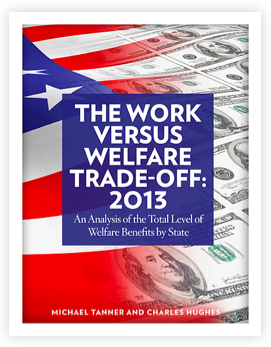Debunking conservative myths about poverty

A wildly misleading report released recently by the conservative Cato Institute says that it pays to be jobless and poor. In an attempt to bolster a laughably farfetched theory sometimes referred to as “the hidden prosperity of the poor,” the authors conclude that the “welfare system provides such a high level of benefits that it acts as a disincentive for work.”
Not surprisingly, however, neither the theory nor the findings in the report stand up to serious scrutiny. Indeed, as a result of several obvious and truck-sized flaws in the analysis, there is every reason for the report to be quickly ignored and/or discarded by both policymakers and anyone else who cares about basing public policy on facts and rigorous study.
The first and most blatant error in the report is the authors’ enormous exaggeration of the public benefits that most people living in poverty actually receive. To bolster their case, the authors assume that the “typical welfare family”—which they define as a single mother with two children—receives each of the following services: Temporary Assistance for Needy Families (TANF), SNAP (formerly known as Food Stamps), WIC (a nutrition program for pregnant and postpartum women and young children), Medicaid, housing assistance, utilities assistance, and emergency food assistance. But this is simply not the case in North Carolina or anywhere else in the United States. The vast majority of poor people do not receive all the services they are eligible for, in part because there are not enough funds to allow that.
For example, the share of poor families in North Carolina that receive TANF benefits is actually very, very small: for every one hundred families in poverty, there are just nine families receiving TANF benefits. Nationally, that figure jumps to only 27. Moreover, the majority who receive assistance do so only for short periods of time – in part-due to federal time limits that have been in place for more than 15 years. Additionally, fewer than one in five SNAP households with children receive TANF and fewer than one in ten of WIC participants receive TANF nationally—meaning there is little overlap among many of these assistance programs.
A second egregious error is the authors’ gross underestimate of the assistance that families who work but earn low-incomes receive. The authors incorrectly assume that safety net benefits are available only to nonworking families. But again, this is completely untrue. All of the benefits included in the analysis are, in fact available to working families. So it is no surprise that nearly four in ten SNAP recipients in North Carolina are in working families. In fact, TANF requires work-eligible individuals to participate in work requirements in order to receive benefits at all.
The authors’ analysis also ignores significant changes to the nation’s safety over the last 30 years. As noted in a recent response to the Cato claims authored by experts at the widely-respected Center on Budget and Policy Priorities, assistance programs are actually designed to offer a lot more support to families who work but earn low wages and far less support to the poorest jobless families with children.
Of course, the dark irony in all of this is that by propagating myths about “welfare,” flawed studies like the Cato report serve to undermine public support for important programs that are primarily designed to encourage work by enabling hard working, low-income families to survive.
Indeed, in light of stagnant wages and the acceleration of low-wage work over the last decade, these supports play a vital role in the daily lives of millions of low-income working families and can mean the difference between getting by and going homeless or hungry.
When so much is at stake for so many adults and children, it is important that policymakers are informed with high-quality analysis and well-researched policy recommendations. Sadly, the Cato study just doesn’t live up to these standards. Let’s hope the public and policymakers alike avoid falling prey to its many distortions.
Tazra Mitchell is a Policy Analyst at the N.C. Budget and Tax Center.
- See more at: http://www.ncpolicywatch.com/2013/09/05/debunking-conservative-myths-about-poverty/#sthash.CPFl0ZKi.dpufBy Tazra Mitchell, NC Policy Watch
A wildly misleading report released recently by the conservative Cato Institute says that it pays to be jobless and poor. In an attempt to bolster a laughably farfetched theory sometimes referred to as "the hidden prosperity of the poor," the authors conclude that the "welfare system provides such a high level of benefits that it acts as a disincentive for work."
Not surprisingly, however, neither the theory nor the findings in the report stand up to serious scrutiny. Indeed, as a result of several obvious and truck-sized flaws in the analysis, there is every reason for the report to be quickly ignored and/or discarded by both policymakers and anyone else who cares about basing public policy on facts and rigorous study.
The first and most blatant error in the report is the authors' enormous exaggeration of the public benefits that most people living in poverty actually receive. To bolster their case, the authors assume that the "typical welfare family" -- which they define as a single mother with two children -- receives each of the following services: Temporary Assistance for Needy Families (TANF), SNAP (formerly known as Food Stamps), WIC (a nutrition program for pregnant and postpartum women and young children), Medicaid, housing assistance, utilities assistance, and emergency food assistance. But this is simply not the case in North Carolina or anywhere else in the United States. The vast majority of poor people do not receive all the services they are eligible for, in part because there are not enough funds to allow that.
For example, the share of poor families in North Carolina that receive TANF benefits is actually very, very small: for every 100 families in poverty, there are just nine families receiving TANF benefits. Nationally, that figure jumps to only 27. Moreover, the majority who receive assistance do so only for short periods of time -- in part due to federal time limits that have been in place for more than 15 years. Additionally, fewer than one in five SNAP households with children receive TANF and fewer than one in 10 of WIC participants receive TANF nationally -- meaning there is little overlap among many of these assistance programs.
A second egregious error is the authors' gross underestimate of the assistance that families who work but earn low incomes receive. The authors incorrectly assume that safety net benefits are available only to nonworking families. But again, this is completely untrue. All of the benefits included in the analysis are, in fact available to working families. So it is no surprise that nearly four in 10 SNAP recipients in North Carolina are in working families. In fact, TANF requires work-eligible individuals to participate in work requirements in order to receive benefits at all.
The authors' analysis also ignores significant changes to the nation's safety net over the last 30 years. As noted in a recent response to the Cato claims authored by experts at the widely-respected Center on Budget and Policy Priorities, assistance programs are actually designed to offer a lot more support to families who work but earn low wages and far less support to the poorest jobless families with children.
Of course, the dark irony in all of this is that by propagating myths about "welfare," flawed studies like the Cato report serve to undermine public support for important programs that are primarily designed to encourage work by enabling hard working, low-income families to survive.
Indeed, in light of stagnant wages and the acceleration of low-wage work over the last decade, these supports play a vital role in the daily lives of millions of low-income working families and can mean the difference between getting by and going homeless or hungry.
When so much is at stake for so many adults and children, it is important that policymakers are informed with high-quality analysis and well-researched policy recommendations. Sadly, the Cato study just doesn't live up to these standards. Let's hope the public and policymakers alike avoid falling prey to its many distortions.
* * *
Tazra Mitchell is a policy analyst at the N.C. Budget and Tax Center.
Tags
NC Policy Watch
A project of the N.C. Justice Center, N.C. Policy Watch is a news and commentary outlet dedicated to informing the public and elected officials as they debate important issues and to improving the quality of life for all North Carolinians.
